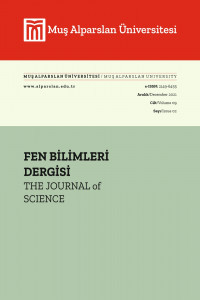İyonkürede jeomanyetik aktivite günlerine göre ‘O+ + N2 → NO+ + N’ reaksiyonunun çarpışma parametrelerinin değişimi
Bir plazma çok sayıda yüklü parçacık etkileşimlerini
içeren bir ortamdır. Bu nedenle plazmayı kinetik teori açısından incelemek
yaygın ve uygundur. Bu bağlamda
jeomanyetik olarak sakin gün (04/09/2017) ve tedirgin gün (08/09/2017) için ‘O+ + N2 → NO+
+ N’ reaksiyonuna ait çarpışma dinamikleri kinetik teori yardımıyla
iyonküresel yüksekliler için hesaplandı. Hesaplama sonucunda ortalama serbest
yol değerlerinin beklenildiği gibi tedirgin günde daha düşük olduğu görüldü.
Toplam çarpışma sayısının ise hem sakin hem de tedirgin günde hmF2
yüksekliklerinde maksimuma ulaştığı ve tedirgin gün değerlerinin daha büyük
olduğu belirlendi. Çarpışma frekansının ise üstel olarak azaldığı görüldü.
Anahtar Kelimeler:
Çarpışma frekansı, jeomanyetik fırtına, iyonküre
The change of the collision parameters of ‘O+ + N2 → NO+ + N’ reaction according to geomagnetic activity days in the ionosphere
A plasma is a
medium containing a large number of charged particle interactions. For this reason, it is common and appropriate to
examine the plasma in terms of kinetic theory. In this context, the collision
dynamics of the ‘O+ + N2
→ NO+ + N’ reaction for geomagnetically quiet day (04/09/2017)
and disturbed day (08/09/2017) were calculated for ionospheric altitudes with
the help of kinetic theory. As a result of the calculation, it was seen that
the mean free path values were less on the disturbed day, as expected. The
total collisions number was seen to reach maximum at the height of hmF2 on both
quiet and disturbed days, and the disturbed day values were greater. It was
seen that the collision frequency decreased exponentially with altitude.
Keywords:
Collision dynamics, ionosphere, geomagnetic storm,
___
- [1] Fuller‐Rowell T., Codrescu M., Roble R., Richmond A. How does the thermosphere and ionosphere react to a geomagnetic storm? Magnetic storms, 203-225, 1997. [2] Buresova D., Lastovicka J. Changes in the F1 region electron density during geomagnetic storms at low solar activity. Journal of Atmospheric and Solar-Terrestrial Physics, 63, 537-544, 2001. [3] Polekh N., Zolotukhina N., Kurkin V., Zherebtsov G., Shi J., Wang G., Wang Z. Dynamics of ionospheric disturbances during the 17-19 March 2015 geomagnetic storm over East Asia. Advances in Space Research, 60, 2464-2476, 2017: [4] Ratcliffe J.A., Weekes K. The ionosphere. Disturbances and storms in the ionosphere. In: Ratcliffe, J.A. (Ed.), Physics of the Upper Atmosphere. The University Press Aberdeen, Great Britain. 1960. [5] Yaşar M. Investigation of the O++H2 → OH++H reaction by quantum mechanical approach in the ionosphere, Firat University, Institute of Science. 2017. [6] Kirk J.G., Melrose D.B., Priest E.R. Plasma Astrophysics: Saas-Fee Advanced Course 24. Lecture Notes 1994. Swiss Society for Astrophysics and Astronomy. Vol. 24, Springer Science Business Media. 2006. [7] Graille B., Magin T.E. Massot M. Kinetic theory of plasmas: translational energy. Mathematical Models and Methods in Applied Sciences, 19, 527-599, 2009. [8] Rees M.H. Physics and chemistry of the upper atmosphere. Vol. 1, Cambridge University Press. 1989. [9] Aydogdu M., Güzel E., Yesil A., Özcan O., Canyilmaz M. Comparison of the calculated absorption and the measured field strength of HF waves reflected from the ionosphere. Nuovo Cimento C Geophysics Space Physics C 30, 243-253, 2007. [10] Schunk R., Nagy A. Ionospheres: physics, plasma physics, and chemistry. Cambridge university press.Sen M., Cakar O., Experimental modal analysis of a polyurethane sandwich panel, International Conference on Engineering and Natural Science (ICENS), Sarajevo, Bosnia. 2016, 2009. [11] Yaşar M., Canyılmaz M. Investigations of chemical processes of O+ +H2(V=0, J=0) reaction using thermal variation in the ionospheric regions. Thermal Science, 270-270, 2017. [12] Alisoy H., Yesil A., Koseoglu M., Unal I. An approach for unipolar corona discharge in N2/O2 gas mixture by considering townsend conditions. Journal of Electrostatics, 69:4, 284-290, 2011.
- ISSN: 2147-7930
- Yayın Aralığı: Yılda 2 Sayı
- Başlangıç: 2013
- Yayıncı: Muş Alparslan Üniversitesi
Sayıdaki Diğer Makaleler
İyonosferik E Bölgesi Akım Yoğunlukları Üzerinde Stratosferik QBO’nun Olası Etkisi
Kentsel Yaşama Bilimsel, Görsel, Rekreasyonel Katkılar; Botanik Bahçeleri
Yasemin MUMİNOĞLU, Bahar TÜRKYILMAZ TAHTA, Bahriye GÜLGÜN ASLAN
Mehmet YAŞAR, Ramazan ATICI, Selçuk SAĞIR
Drinfeld-Sokolov Denkleminin IBSEFM Yöntemiyle Yeni Çözümleri
Palm Yağı Katkılı Mürekkeplerin Baskı Kalitesine Etkisinin Belirlenmesi
Elif URAL, Zafer ÖZOMAY, Lütfi ÖZDEMİR
Marrubium parviflorum subsp. parviflorum Bitkisinin Yağ Asidi ve Uçucu Yağ Kompozisyonu
